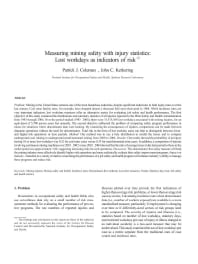Mining Publication: Measuring Mining Safety with Injury Statistics: Lost workdays as Indicators of Risk
Original creation date: December 2007
Authors: PJ Coleman, JC Kerkering
Mining in the United States remains one of the most hazardous industries, despite significant reductions in fatal injury rates over the last century. Coal mine fatality rates, for example, have dropped almost a thousand-fold since their peak in 1908. While incidence rates are very important indicators, lost worktime measures offer an alternative metric for evaluating job safety and health performance. The first objective of this study examined the distributions and summary statistics of all injuries reported to the Mine Safety and Health Administration from 1983 through 2004. Over the period studied (1983-2004), there were 31,515,368 lost workdays associated with mining injuries, for an equivalent of 5,700 person-years lost annually. The second objective addressed the problem of comparing safety program performance in mines for situations where denominator data were lacking. By examining the consequences of injuries, comparisons can be made between disparate operations without the need for denominators. Total risk in the form of lost workday sums can help to distinguish between lower and higher-risk operations or time periods. Our method was to use a beta distribution to model the losses and to compare underground coal mining to underground metal/nonmetal mining from 2000 to 2004. Our results showed the probability of an injury having 10 or more lost workdays was 0.52 for coal mine cases versus 0.35 for metal/nonmetal mine cases. In addition, a comparison of injuries involving continuous mining machines over 2001-2002 versus 2003-2004 showed that the ratio of average losses in the later period to those in the earlier period was approximately 1.08, suggesting increasing risks for such operations. This denominator-free safety measure will help the mining industry more effectively identify higher-risk operations and more realistically evaluate their safety improvement programs. Attention to a variety of metrics concerning the performance of a job safety and health program will enhance industry's ability to manage these programs and reduce risk.

- Applying Robust Design to Study the Effects of Stratigraphic Characteristics on Brittle Failure and Bump Potential in a Coal Mine
- Elastic and Shear Moduli of Coal Measure Rocks Derived from Basic Well Logs Using Fractal Statistics and Radial Basis Functions
- Electromagnetic Noise in Itmann Mine
- Mining Fact Sheets
- Portable XRF Analysis of Occupational Air Filter Samples from Different Workplaces Using Different Samplers: Final Results, Summary and Conclusions
- Practical Risk Assessment Guidelines for Identifying, Assessing, and Mitigating Stored Energy Hazards in Underground Coal Mines During and After a Mine Emergency
- Preventing Equipment Related Injuries in Underground U.S. Coal Mines
- SPONCOM - A Computer Program for the Prediction of the Spontaneous Combustion Potential of an Underground Coal Mine
- SponCom - Spontaneous Combustion Assessment Software - 2.0
- Technology News 545 - NIOSH Updates Spontaneous Combustion Assessment Software